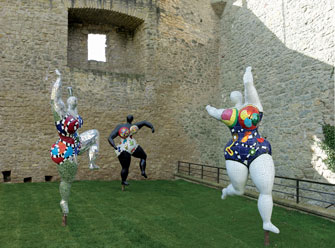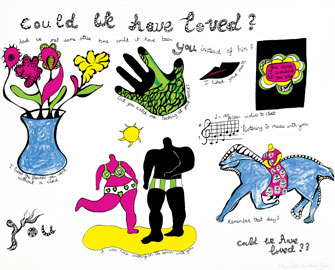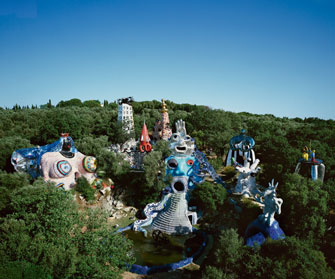Art That Saves,
Art That Kills

“Les Trois Grâces” (1995-2003). © 2014 Niki Charitable Art Foundation. Photo: Philippe Cousin
It seems that everyone in the world is familiar with Niki de Saint Phalle’s “Nanas,” those monumental sculptures of curvaceous goddesses bursting with joy and clashing colors, but there is much, much more to the artist, as the marvelous new retrospective of her work at the Grand Palais amply demonstrates.
Born the child of a French count and an American mother in 1930, she seemed to have had it all: not only was she talented but she was also thin and beautiful enough to be a model for Vogue and other magazines. As a teenager, she was already showing her artistic and rebellious sides when she got kicked out of a ritzy New York school for painting the fig leaves on its statues red.
Like her near-contemporary Louise Bourgeois, another French woman artist transplanted to the United States, Saint Phalle has a fascinating life story, marked by sexual abuse in childhood (she was raped by her father at the age of 11) and followed by a life-long, one might say life-saving, immersion in the making of art. Both women were obsessed with the figure of the mother as both creator and destroyer, and both sometimes represented her as a spider, a paradoxically menacing protector.
The show starts with some rather derivative (of Jackson Pollock; she even gives him credit in the title of one work) yet surprisingly beautiful paintings from the 1950s: half Pollock-style drips and half objects embedded in heavily applied paint. Apparently these were made after a suicidal Saint Phalle had been in a psychiatric ward for severe depression and had undergone electroshock therapy. Art therapy, which she took up after this experience, proved to be more effective.
Perhaps the most cathartic of her works were her “Shooting Paintings” of the early 1960s. She would attach bags of paint of different colors to a canvas and then shoot at them

“Niki de Saint Phalle Taking Aim” (1972). From her film “Daddy.” © Peter Whitehead
with a rifle to explode the paint bags, stopping when she was satisfied with the colors and composition. These pieces, many of which are on display in the show, earned her fame and an invitation to join the otherwise all-male French New Realists movement.
There is a dichotomy evident in the early works, which include assemblages with a joyous feel but sinister underlying currents, incorporating both children’s toys and guns, knives and cleavers. Saint Phalle took the assemblage technique further in the mid-1960s with her “Brides” and “Prostitutes,” monumental sculptures covered in the detritus of a woman’s life, forerunners of the “Nanas.”
The large room in the exhibition featuring the “Nanas” is positively magical. Some of the figures, caught in dance movements, revolve on rotating platforms while their mirrored surfaces shoot rays of light around the room like a mirror ball in a dance hall.
An unabashed feminist, Saint Phalle explains in a filmed interview that the “Nanas” have small heads to protest against the abstract, scientific spirit that “devours us.” The “Nanas are themselves,” she says, and they don’t need men.
The festive atmosphere of the room is tempered by the works hanging on the walls, lithographs of illustrated diary entries and letters to friends that look cheery and colorful but whose content is often less so, notably those documenting the end of love affairs, full

“Could We Have Loved?” (1968). © 2014 Niki Charitable Art Foundation, all rights reservedof self-questioning about her inability to make relationships work (surely these must have been an inspiration for Sophie Calle’s autobiographical installations?).
This fascinating and exhaustive exhibition ends with films and models of the sculpture park (originally inspired by Antoni Gaudí’s Park Güell in Barcelona) that she created in

The Tarot Garden in Garavicchio, Italy. © Laurent Condominas Tuscany, the Tarot Garden, with its building-
sized sculptures, some of which were designed to be lived in.
Niki de Saint Phalle died in 2002, killed by her art: her fatal emphysema was caused by the toxic polyester fumes she inhaled for many years while making her sculptures.
In Paris, works by Niki de Saint Phalle are permanently on show in the “Stravinsky Fountain” next to the Centre Pompidou, created with her former husband Jean Tinguely. A monumental sculpture of a skull, “La Cabeza,” is on show at Centquatre until February 2, while “La Nana Danseuse (Rouge d’Orient-Bloum)” will grace the Berges de Seine through November 2.
Galeries Nationales du Grand Palais: 3, avenue du Général Eisenhower, 75008 Paris. Métro: Champs-Elysées Clemenceau. Tel.: 01 44 13 17 17. Open Wednesday-Saturday, 10am-10pm (until midnight on October 4); Sunday-Monday, 10am-8pm. Closed Tuesday and December 25. Admission: €13. Through February 2, 2015. www.grandpalais.fr
Click here to read all of this week’s new articles on the Paris Update home page.
Reader Reaction: Click here to respond to this article (your response may be published on this page and is subject to editing).
Support Paris Update by ordering books from Paris Update’s Amazon store at no extra cost. Click on your preferred Amazon location: U.K., France, U.S.
© 2014 Paris Update
Favorite